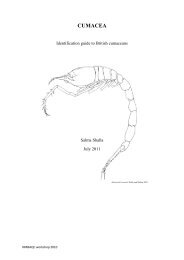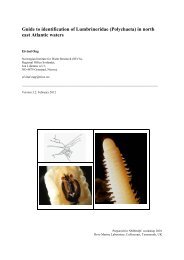s A Field Guide to the British Seaweeds - NMBAQC
s A Field Guide to the British Seaweeds - NMBAQC
s A Field Guide to the British Seaweeds - NMBAQC
You also want an ePaper? Increase the reach of your titles
YUMPU automatically turns print PDFs into web optimized ePapers that Google loves.
• Reproductive structures – <strong>the</strong>se can vary considerably between species<br />
<strong>the</strong>refore may aid with identification for example:<br />
o Fucus spiralis – <strong>the</strong> fruiting bodies/receptacles are<br />
inflated, round and often have a rim of sterile material<br />
o Fucus serratus – receptacles flattened with extended growth<br />
o Fucus vesiculosus – receptacles inflated, elongated and<br />
pointed<br />
o Pilayella lit<strong>to</strong>ralis – intercalary sporangia where <strong>the</strong> cells<br />
within which spores are contained are located between <strong>the</strong><br />
base and apex of <strong>the</strong> plant<br />
o Ec<strong>to</strong>carpus sp. and Giffordia sp. – plurilocular<br />
sporangia (reproductive structures with many<br />
compartments) are located on stalks, may be<br />
elongated, spindle, ovoid or conical shaped<br />
Reduced species list identification guide as required by <strong>the</strong> Water Framework Directive 16




